
An exaltation of larks whirled and sang above the hut where he lay dying nearly a millennium ago.
That’s only one of the countless stories told of Saint Francis of Assisi, whose October 4 feast will be celebrated here at Notre Dame not only with the customary Mass but also with a lecture on “Sustainability and Catholic Theology” and “nature-themed” desserts in the student dining halls.
Many of the stories that swirl about his name have a whiff of fantasy, but even the most skeptical agnostics have always found the documentable aspects of Giovanni Francesco Bernardone’s life fantastic enough. Nicknamed Francesco (“Frenchy”) by his father, Francis filled the 44 years between his birth and the valedictory song of those larks with, among other things, a hell-raising youth, extravagant wealth, military bloodshed, a searing conversion, utter (and paradoxically joyful) poverty, an aversion to comfortable shelter, and travel throughout the known world of his time.
His feast day is an excellent time to call to mind how much more challenging a figure he really is than that rather mild, doe-eyed flower child presiding over the birdbath in your backyard.
To cite only one example — and one that reverberates in our own time: During the bloodiest days of the Fifth Crusade, Francis crossed the battle lines between the Christian and Muslim worlds, singing the 23rd Psalm, and told the astonished Saracen pickets that he wished to speak with their leader, al-Kamil, the Sultan of Egypt, who was as hated and feared in the 13th century as Osama bin Laden was in the 21st. Perhaps out of deference to an evidently demented wanderer, they didn’t behead him on the spot, but brought him to al-Kamil, who was first bewildered and then charmed to learn that Francis wished not only to obtain peace between the warring Christian and Muslim worlds, but al-Kamil’s conversion to Christianity.
Francis was disappointed on both counts, as the war continued and the Sultan continued to profess Islam, but he was released with his head still attached to his body and grateful to have made a new friend, for whom he prayed the rest of his life.
G.K. Chesterton alluded to that encounter in his biography of Saint Francis. “What gave him his extraordinary personal power was this,” Chesterton wrote. “that from the Pope to the beggar, from the sultan in his pavilion to the ragged robbers crawling out of the wood, there was never a man who looked into those brown burning eyes without being certain that Francis Bernardone was really interested in him; in his own inner individual life from the cradle to the grave; that he himself was being valued and taken seriously.”
It shouldn’t be surprising that a character like that can shine through half the Christian era with such force and vivacity. Francis was, is, an almost terrifying example of what happens when a human being stakes his entire life on the imitation of Christ . . . and succeeds.
No wonder the world can bear to include such a person only every thousand years or so.
Michael Garvey is Notre Dame’s assistant director of public information and communication. Email him at garvey.2@nd.edu.